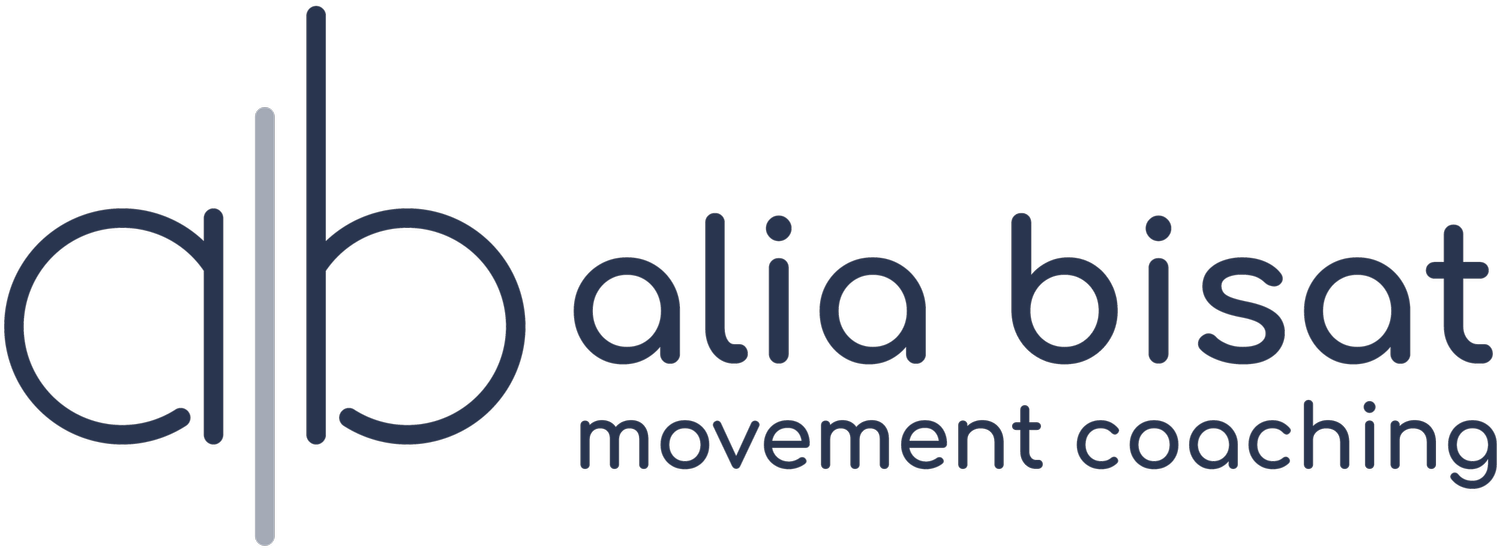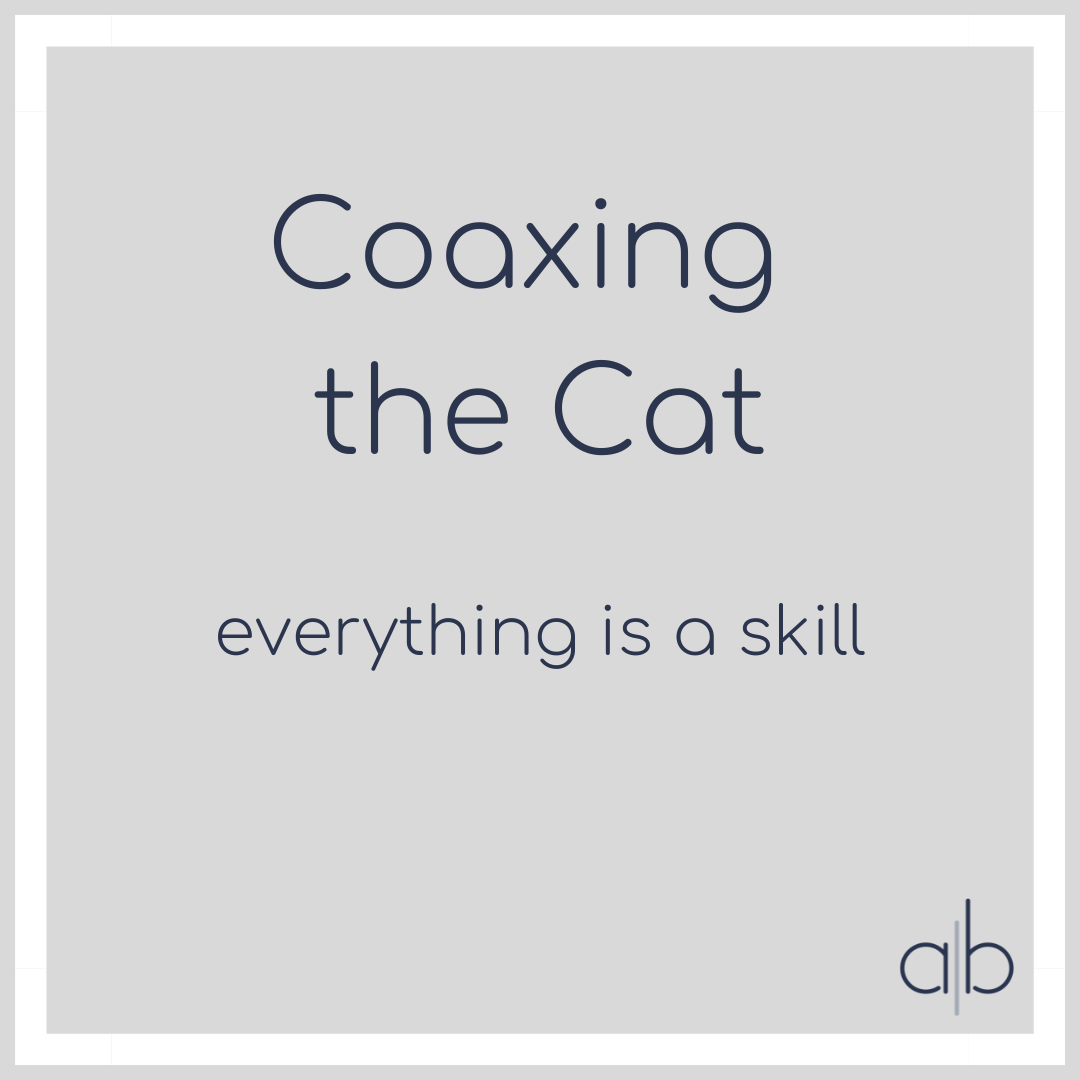Coaxing the Cat: everything is a skill
How Cats Operate
If you know anything about cats, you know that they can be skittish. They often don’t openly trust new people or new environments, so you have to coax their trust over time. Recently, a neighbor’s cat has been approaching our deck. It started with her resting on the ledge of the perimeter, on the outside of the fence. After a few weeks, she came through the fence onto the deck but stayed on the far side, furthest away from the doors to our apartment. At first, eye contact with her was enough to send her away. Slowly, she became more comfortable and would venture half-way down the deck. One time, I got too excited, I tried to approach her, and she immediately bolted -- I knew it would be a few weeks before I would see her again. She finally came back and I would just pretend I didn’t notice her until one day I was sitting on my couch inside the apartment with the deck doors open, working on my computer. I looked up to see her head poking into the apartment! I really tried to contain my excitement, but just couldn’t do it. As soon as I moved toward her, she bolted again. But this time I knew we had developed enough of a foundation of trust that she would be back sooner than later.
All this cat wants to know is if she’s safe to come closer. Your brain is no different. Assessing safety and building trust is how your body learns to move again with chronic pain. Like a skittish cat who needs to be coaxed with patience. Let me explain. But first, let’s talk about how all movements are skills.
What's a skill? (Disclaimer – for ease of language, I’m going to use the word “skill” to reference the neurological component of movement. Technically in the research, “skill" has more specific attributes to it.) If I said, “Ok, we’re going to practice the cartwheel,” it would probably make sense to you that the cartwheel is a skill. A skill is “dexterity or coordination especially in the execution of learned physical tasks.” While the cartwheel involves certain degrees of strength and mobility it’s mostly about coordinating that strength and mobility in a way that looks smooth and easeful, avoiding falling, injury, or pain. It would probably make sense to you that as you practiced it, you would get better at it, just like learning a language, driving a car, or dicing an onion.
If I said, “Ok, we’re going to practice lifting a kettlebell off the floor,” you might assume this is only strength driven. You either have the muscle mass and power to do it or you don’t and that’s that. But what if I told you that picking up a kettlebell is as much of a skill as a cartwheel? It’s also something that requires dexterity and coordination to be done smoothly, effectively, and without pain.
Running? It’s a skill. High intensity interval training? Skill. Powerlifting? Skill. Hiking? Skill Yes, cardiovascular endurance, strength, and mobility are needed in various amounts for each activity. But at the end of the day, you can have all those things, and you may still struggle the first time you run or the first time you survive a HIIT class.
Every movement we make and every form of exercise we choose is a skill because: we’re coordinating an immense amount of data that’s bombarding our nervous system with the ability to produce force in a way that perfectly aligns with the task we’re trying to accomplish. The data we’re processing at any given movement is:
Anything coming in from our external senses (sight, smell, touch, hearing, taste)
Anything coming in from our internal landscape (heart rate, bladder fullness, blood pressure, breathing rate, digestive function, proprioception, head position, etc).
All of our conscious thoughts (“I love these new shoes!” “I’m so frustrated with my boss.”)
All of our subconscious thoughts (the cumulative history and past experiences of our entire lives)
Ok, so now we’ve established that all movements and exercise endeavors are skills. Here are two different examples to showcase what I mean.
Heavy Lifting as a Skill
Barbara comes to me because she’s in her late 60’s and has been told she needs to lift weights to preserve her muscle mass and strength. She’s been lifting weights for several years but doesn’t feel stronger and was recently diagnosed with osteopenia. She thinks something is missing in her training. We have a consult and she understands that she needs to lift heavy weights to produce the strength improvement she’s looking for and to help preserve and increase her bone density.
I watch Barbara move and lift some lighter dumbbells and can see that she does plenty of repetitions without breaking form or showing signs of fatigue. I can tell she hasn’t tapped into her capacity with her current training regimen. Let’s take her double suitcase lift for example. (A double suitcase lift is when you have two weights on either side of you and you bend down to pick them up off the floor. Imagine picking up two suitcases). She can easily do 15 repetitions of 20lb on each side. It’s clear from watching her that she has the muscle capacity to lift three times that amount. But our movements are never just about muscle capacity. She doesn’t have the experience of producing high levels of force yet. Lifting heavy will feel very different, it requires a different level of concentration, different neuromuscular coordination, different level of force production, not to mention the ideas, experiences, or prejudices she may have about lifting heavy that will influence how she feels while doing it. I would never give her three times the weight off the bat. We would work up to it and practice it just like any other skill. Eventually, Barbara will learn and feel more comfortable with the skill of lifting really heavy weights off the floor. And here’s the best part. The skill will translate to lifting overhead, carrying, squatting, and pulling. While she will still need to practice those exercises individually because they utilize different muscle groups and also require some of their own unique sets of skills, the skill of exerting herself with high loads, will be one she's already developed and will help her improve her other lifts faster.
Why might you care about this? For starters, it might help you get less frustrated when you can’t do something. People often get frustrated because they feel like they should be able to do something based on what they know about their body’s physical capabilities. They feel like their body is failing them because they’ve forgotten that their body needs to relearn the movement from a neurological perspective. They need a reintroduction to the skill.
In the context of chronic pain, it might help you feel like there’s hope.
Skill Learning and Pain
The scientific community has long established that damage at the level of our tissues doesn’t explain our pain very well. This means that we don’t have to fix the herniated disc, the labral tear, or the arthritis in order to execute pain free movement because there are other factors at play with chronic pain that we can modify. One of those factors is relearning a skill with slow and steady exposure to it. Aka, coaxing the trust of a skittish cat.
Drew has had on and off chronic back pain for a few years. Bending down to pick something up is a stressful task, and when he bends down, he squats down to avoid any rounding in his back. (Click here to read more about rounding vs squatting to lift something). Bending down and rounding your back to pick up a pen doesn’t require muscular strength. It requires a coordination of a variety of movements and an interplay of factors such as neuromuscular signaling, past experiences of pain, and muscular tension patterns. This interplay has resulted in painful movement when bending down for Drew for a long time so he’s avoided it. The ability to round his back to get closer to the ground is a skill he’s now lost over time.
To relearn this skill, we coaxed the cat by convincing it that it’s safe. First we approached bending the spine in positions that felt the least threatening like laying down on his back or in a hands and knees position. We progressed over severalweeks towards bending forward with wall support. One session, we accidentally scared the cat. Drew showed up that day more anxious than usual due to work stress, and the bending exercises we did caused a mild flare up. Understandably, like a scared cat, the trust was broken between him and his nervous system for a little while. BUT the cat returned! We slowly worked back up to where we left off. With gentle coaxing, we reintroduced bending forward from standing and Drew is now picking up 20 pounds off the floor with a very rounded spine, with ease, and no discomfort.
What You Can Do
The next time you want to do a movement you know tends to cause pain, try warming up the skill just like you warm up your muscles before you would go out for a run. Doing this actually has a name, it’s called “neural priming.” You’re warming up, or priming, your nervous system for the movement to come. You’re trying to coax the cat, not spook it at first sight! When someone prepares for a deadlift with heavy weight they do several rounds of deadlifting with lighter weight. Yes, this warms up the muscles but it also prepares the entire system for the coordination of the movement, the force they want to produce, how to breathe, what to think about while lifting, etc. You can try this with anything – just do a few repetitions of the movement you’re about to do but in its easiest form. Test it out, see how you’re feeling, and assess what today’s practice session should look like.
As you continue your practice or training, take your time as you gradually increase how much you’re doing. This long term cat coaxing is called “graded exposure.” Understand that you probably will scare the cat at some point – doing too much and causing a bit of flare up. Don’t fret! If you need a reminder of what to do in those situations, read this post I wrote about how to manage your immediate reactions at the onset of a new or recurring pain. Take a rest, stay patient, and continue with your coaxing. The cat will come back if you coax it patiently.
(I could take this analogy a step further and say that coaxing with food helps bring the cat closer, right? Food in this analogy would be celebrating your progress. I know how lame that sounds but there’s a dopaminergic explanation for this and IT WORKS. Acknowledge your progress and celebrate your small win yourself every time you complete a movement with less pain, more fluidly, or with more weight. Recognizing your progress will help you stay motivated to continue, increase your sense of self-efficacy, and contribute to a sense of safety for your nervous system.)
Till next time, keep moving.
Related Reading:
There are no bad movements: how to pick something off the floor
Managing your thoughts on the onset of pain
Moving while in pain
Chronic pain takes time

